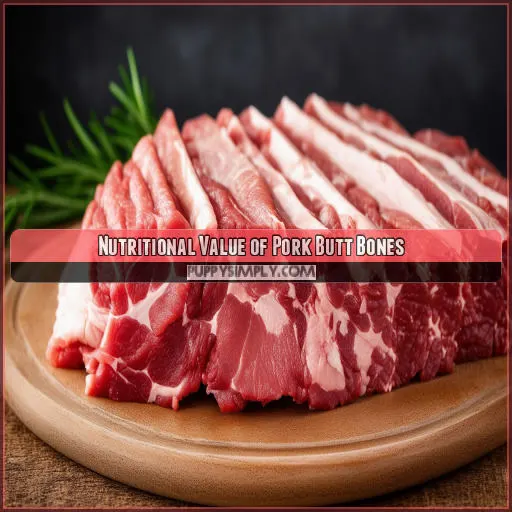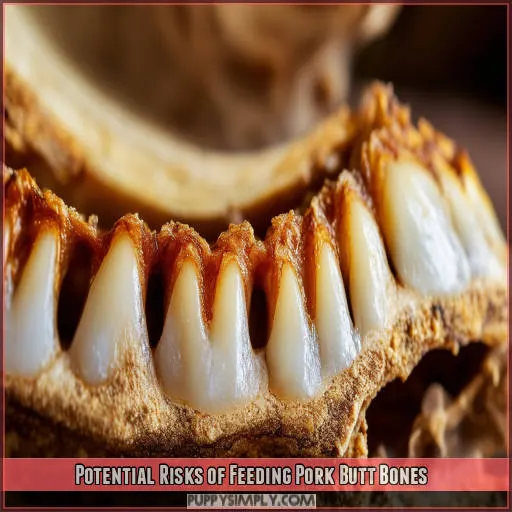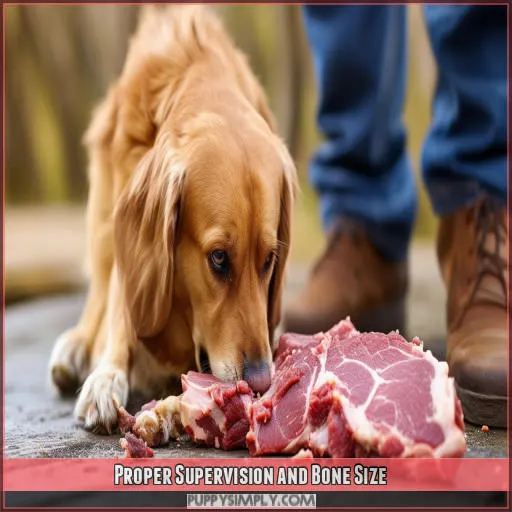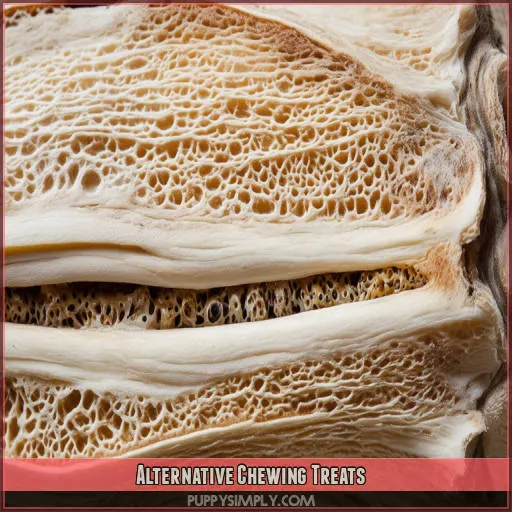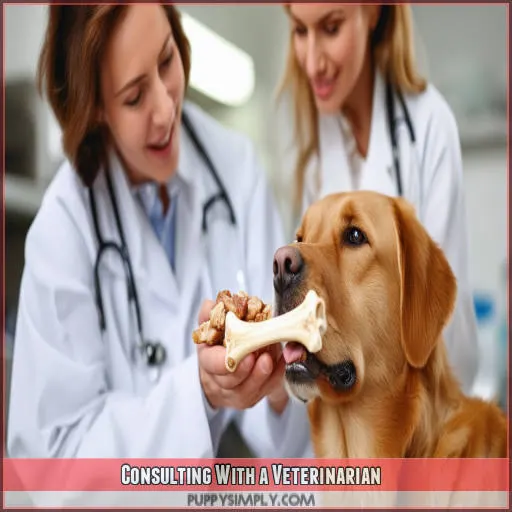This site is supported by our readers. We may earn a commission, at no cost to you, if you purchase through links.
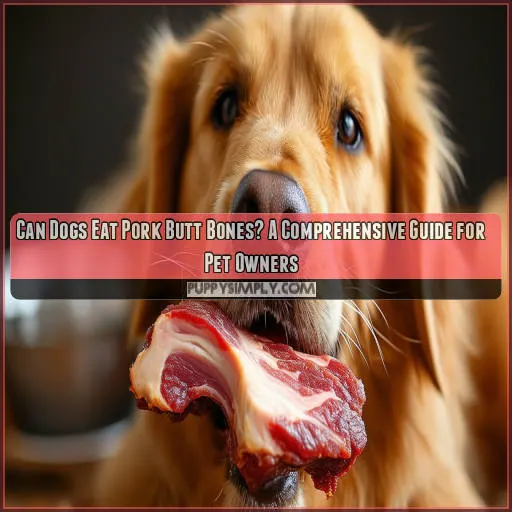 You’re wise to question whether dogs can eat pork butt bones.
You’re wise to question whether dogs can eat pork butt bones.
While seemingly a tasty treat, these bones pose significant risks that simply aren’t worth it. They can splinter into sharp shards, potentially causing punctures, choking hazards, or intestinal blockages.
Cooked bones become extremely brittle, exacerbating the danger.
Your furry friend’s safety should be the top priority, so it’s best to steer clear of pork butt bones altogether.
Fortunately, plenty of safer chewing options exist that can satisfy their gnawing needs without compromising their well-being.
Want to learn more about keeping Fido content and healthy?
Table Of Contents
Key Takeaways
- Listen up, pup parents! While those juicy pork butt bones might seem like a drool-worthy treat, they’re a risky business for your furry friend. Those pesky shards could puncture their precious insides or cause a serious choking hazard. Not worth risking your pup’s health for a gnaw session, am I right?
- But fret not, my fellow dog lovers! There’s a whole world of safer chewing options out there to satisfy your canine’s cravings. We’re talking rawhide, bully sticks, and dental chews that’ll keep their chompers happy without compromising their well-being. It’s a win-win!
- Now, let’s be real here. Moderation is the name of the game when it comes to treats. An occasional pork butt bone might offer some nutritional perks, but it shouldn’t replace a balanced, complete diet. Your pup’s health should always come first, even if that means saying "no" to those puppy dog eyes.
- Last but not least, your trusty vet is your secret weapon in navigating the world of doggy delicacies. They know your pup’s unique needs like the back of their hand and can guide you towards safe, satisfying chewing options. Because at the end of the day, a happy, healthy pup is what we’re all barking for, right?
Can Dogs Eat Pork Butt Bones?
No, dogs shouldn’t eat pork butt bones. Pork bones are dense and can splinter, posing a risk of tearing the digestive tract or causing an obstruction.
Nutritional Value of Pork Butt Bones
While pork butt bones can provide some nutritional value for dogs, it’s important to be cautious.
The bone marrow is rich in healthy fats and minerals like calcium, which aid in strong bones and teeth. However, the protein content is relatively low compared to other chews.
Gnawing on bones can help scrape away plaque for better dental health, but be mindful of the calorie count if your pup is on a diet.
Ultimately, moderation is key – an occasional pork butt bone as a treat can offer minor nutritional perks, but shouldn’t replace a balanced, complete diet.
Potential Risks of Feeding Pork Butt Bones
While pork butt bones may seem like an enticing chew treat, they pose significant risks that you shouldn’t overlook. First, they can splinter into sharp shards, leading to:
- Punctures in the mouth, throat, or digestive tract
- Choking hazards
- Intestinal blockages
Additionally, bones harbor harmful bacteria like Salmonella, potentially causing digestive upset or pancreatitis in dogs. Even cooked bones aren’t safe, as they become brittle and prone to splintering. As a responsible pet owner, it’s vital to weigh the dangers against any perceived benefits before offering your furry friend these risky treats.
Proper Supervision and Bone Size
Proper supervision and appropriate bone size are crucial when offering pork butt bones to your furry companion.
Always clean the bones thoroughly, removing any sharp edges or fragments that could splinter and pose a choking hazard.
Monitor your dog closely as they chew, ensuring they don’t ingest large pieces that could cause an intestinal blockage.
Pork bones are dense and can cause dental damage if chewed excessively, so limit their access and provide alternative chews.
Consider the size of the bone relative to your dog’s breed and chewing ability. Larger dogs may handle larger bones better, but smaller breeds require extra caution with appropriately sized bones.
Alternative Chewing Treats
While pork butt bones may seem enticing as chew treats for dogs, they pose significant risks. Safer options for dog chews include rawhide, bully sticks, dental chews, and rubber or nylon toys, which provide a satisfying chewing experience without the potential dangers of bone fragments or obstruction.
Safer Options for Dog Chews Include:
While bones offer nutritional benefits, you may want to contemplate safer chewing options to prevent potential health risks. Rawhide, bully sticks, and dental chews made from natural ingredients can satisfy your dog’s chewing needs without posing choking hazards or exposing them to artificial flavors or synthetic materials that could lead to excessive chewing or breed-specific issues.
Rawhide
Rawhide chews offer an alternative for dogs who love to chew. While they can satisfy a dog’s urge to gnaw, rawhide poses choking and digestive risks if not monitored closely. Choose thicker, larger rawhide chews, and avoid those that splinter easily. Weigh rawhide’s drawbacks against the benefits of mental stimulation and dental health.
Bully Sticks
You could also try bully sticks – they’re long-lasting, digestible chews made from dried bull penises. Though durable and flavorful, supervise closely as small pieces can pose a choking risk. Choose thicker bully sticks for larger dogs and thinner ones for smaller pups. If your dog doesn’t take to bully sticks, consider other chew alternatives.
Dental Chews
Speaking of oral hygiene, dental chews tackle plaque, tartar buildup, and prevent gum disease. While nutritious, these treats need caution if your pup has allergies. Check for safe ingredients that scrape teeth without harming gums. Proper sizing prevents choking hazards while freshening breath and promoting dental health.
Rubber or Nylon Toys
Rubber or nylon toys offer a durable, safe chewing option. They won’t splinter like bones, potentially causing intestinal issues. Some come flavored for extra appeal, while others have treat-dispensing features for interactive play. Tough toys can also aid in training by rewarding calm chewing habits. With proper supervision, they’re a worry-free way to satisfy your pup’s gnawing needs.
Consulting With a Veterinarian
You should always consult your veterinarian before introducing any new treats or dietary changes to your furry friend. They have the expertise to evaluate potential risks, like bone marrow or bacterial contamination, and advise on appropriate portions to avoid choking hazards, dental damage, or unwanted weight gain.
Your vet understands your pup’s unique health needs and can provide personalized guidance on safe chewing options. Remember, their top priority is ensuring your beloved companion stays happy and healthy for years to come.
Frequently Asked Questions (FAQs)
Can dogs eat cooked pork butt bones?
Just like that little pup eyeing your pork chop, you may wonder: can dogs eat cooked pork butt bones? The short answer is no – cooked bones can splinter and cause obstructions or lacerations. Stick to safer chew toys or raw, edible bones for your furry friend.
How to introduce pork butt bones safely?
Introduce pork butt bones gradually, ensuring they’re cooked thoroughly and sized appropriately. Supervise closely, removing any small shards or choke hazards. Moderation is key—these treats shouldn’t replace a balanced, nutritious diet.
Are there any age restrictions for dogs?
For safety, pups under 6 months shouldn’t have pork bones. Older dogs can enjoy them occasionally when supervised. Monitor for any digestive issues and remove small pieces to avoid choking hazards.
Can pork butt bones cause digestive issues?
Yes, pork butt bones can cause digestive issues like constipation, blockages, or punctures. They’re dense and can splinter, making them risky for dogs to consume.
What are the signs of bone obstruction?
Potential panicked pooches present profound problems – vomiting, weakness, lethargy signal bone blockages. Keeping calm, closely checking, consulting vets circumvents catastrophe.
Conclusion
While pork butt bones may seem tempting, their potential to splinter poses significant risks that can lead to serious harm.
For your dog’s well-being, it’s wisest to avoid feeding pork butt bones altogether.
Instead, opt for safer chewing alternatives like rawhide, bully sticks, or durable rubber toys.
Consulting your veterinarian can also provide customized guidance on appropriate chews and ensuring your canine companion stays content and healthy.

